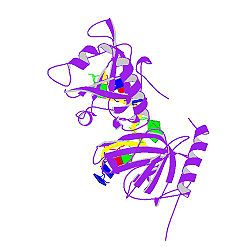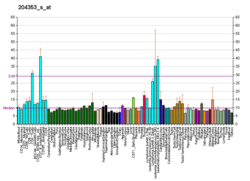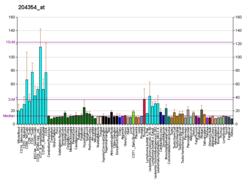- POT1
-
POT1

Protein Data Bank Identificadores Símbolos POT1; DKFZP586D211; hPot1 IDs Externas OMIM: 606478 MGI: 2141503 HomoloGene: 32263 Ontología Génica Función molecular: *Unión a ADN
*Unión a Proteínas
*Unión a ADN telomérico de cadena sencillaComponente celular: *Cromosoma nuclear, región telomérica
*Núcleo
*CromosomaProceso biológico: *Mantenimiento del telomero
*Mantenimiento del telómero via telomerasaPatrón de expresión de ARN Ortólogos POT1 (del inglés: protection of telomeres 1 —protección de telómeros 1) caracterizada por primera vez en S. pombe, es un gen humano.[1]
Este gen es miembro de la familia de la telombina y codifica una proteína nuclear implicada en el mantenimiento de los telómeros. Específicamente, esta proteína funciona como miembro de un complejo multiproteico llamado telosoma que se une a las repeticiones TTAGGG de los telómeros, regulando su longitud y protegiendo al a los extremos del cromosoma de recombinación ilegítima, inestabilidad cromosómica catastrófica y segregación cromosómica anormal. Se asocia un aumento anormal de la expresión en la transcripción con la carcinogénesis gástrica y su progresión. Se han descrito variantes por splicing alternativo.[1]
Referencias
Bibliografía
- de Lange T (2005). «Shelterin: the protein complex that shapes and safeguards human telomeres.». Genes Dev. 19 (18): pp. 2100–10. doi:. PMID 16166375.
- Bonaldo MF, Lennon G, Soares MB (1997). «Normalization and subtraction: two approaches to facilitate gene discovery.». Genome Res. 6 (9): pp. 791–806. PMID 8889548.
- Baumann P, Cech TR (2001). «Pot1, the putative telomere end-binding protein in fission yeast and humans.». Science 292 (5519): pp. 1171–5. doi:. PMID 11349150.
- Baumann P, Podell E, Cech TR (2002). «Human Pot1 (protection of telomeres) protein: cytolocalization, gene structure, and alternative splicing.». Mol. Cell. Biol. 22 (22): pp. 8079–87. PMID 12391173.
- Strausberg RL, Feingold EA, Grouse LH, et al. (2003). «Generation and initial analysis of more than 15,000 full-length human and mouse cDNA sequences.». Proc. Natl. Acad. Sci. U.S.A. 99 (26): pp. 16899–903. doi:. PMID 12477932.
- Loayza D, De Lange T (2003). «POT1 as a terminal transducer of TRF1 telomere length control.». Nature 423 (6943): pp. 1013–8. doi:. PMID 12768206.
- Colgin LM, Baran K, Baumann P, et al. (2004). «Human POT1 facilitates telomere elongation by telomerase.». Curr. Biol. 13 (11): pp. 942–6. PMID 12781132.
- Hillier LW, Fulton RS, Fulton LA, et al. (2003). «The DNA sequence of human chromosome 7.». Nature 424 (6945): pp. 157–64. doi:. PMID 12853948.
- Ota T, Suzuki Y, Nishikawa T, et al. (2004). «Complete sequencing and characterization of 21,243 full-length human cDNAs.». Nat. Genet. 36 (1): pp. 40–5. doi:. PMID 14702039.
- Loayza D, Parsons H, Donigian J, et al. (2004). «DNA binding features of human POT1: a nonamer 5'-TAGGGTTAG-3' minimal binding site, sequence specificity, and internal binding to multimeric sites.». J. Biol. Chem. 279 (13): pp. 13241–8. doi:. PMID 14715659.
- Kondo T, Oue N, Yoshida K, et al. (2004). «Expression of POT1 is associated with tumor stage and telomere length in gastric carcinoma.». Cancer Res. 64 (2): pp. 523–9. PMID 14744765.
- Armbruster BN, Linardic CM, Veldman T, et al. (2004). «Rescue of an hTERT mutant defective in telomere elongation by fusion with hPot1.». Mol. Cell. Biol. 24 (8): pp. 3552–61. PMID 15060173.
- Liu D, Safari A, O'Connor MS, et al. (2004). «PTOP interacts with POT1 and regulates its localization to telomeres.». Nat. Cell Biol. 6 (7): pp. 673–80. doi:. PMID 15181449.
- Ye JZ, Hockemeyer D, Krutchinsky AN, et al. (2004). «POT1-interacting protein PIP1: a telomere length regulator that recruits POT1 to the TIN2/TRF1 complex.». Genes Dev. 18 (14): pp. 1649–54. doi:. PMID 15231715.
- Gerhard DS, Wagner L, Feingold EA, et al. (2004). «The status, quality, and expansion of the NIH full-length cDNA project: the Mammalian Gene Collection (MGC).». Genome Res. 14 (10B): pp. 2121–7. doi:. PMID 15489334.
- Lei M, Podell ER, Cech TR (2005). «Structure of human POT1 bound to telomeric single-stranded DNA provides a model for chromosome end-protection.». Nat. Struct. Mol. Biol. 11 (12): pp. 1223–9. doi:. PMID 15558049.
- Veldman T, Etheridge KT, Counter CM (2005). «Loss of hPot1 function leads to telomere instability and a cut-like phenotype.». Curr. Biol. 14 (24): pp. 2264–70. doi:. PMID 15620654.
- Kelleher C, Kurth I, Lingner J (2005). «Human protection of telomeres 1 (POT1) is a negative regulator of telomerase activity in vitro.». Mol. Cell. Biol. 25 (2): pp. 808–18. doi:. PMID 15632080.
- Yang Q, Zheng YL, Harris CC (2005). «POT1 and TRF2 cooperate to maintain telomeric integrity.». Mol. Cell. Biol. 25 (3): pp. 1070–80. doi:. PMID 15657433.
- Lei M, Zaug AJ, Podell ER, Cech TR (2005). «Switching human telomerase on and off with hPOT1 protein in vitro.». J. Biol. Chem. 280 (21): pp. 20449–56. doi:. PMID 15792951.
Categorías:- Proteínas humanas
- Genes del cromosoma 7
Wikimedia foundation. 2010.


